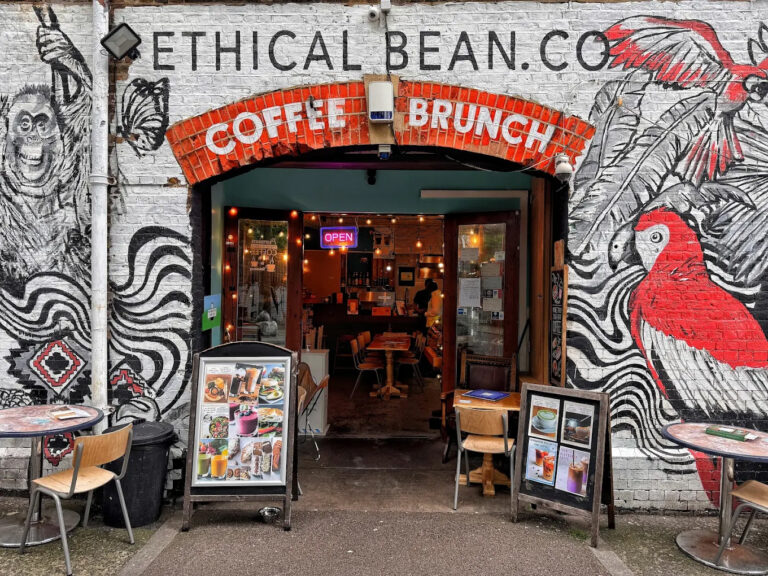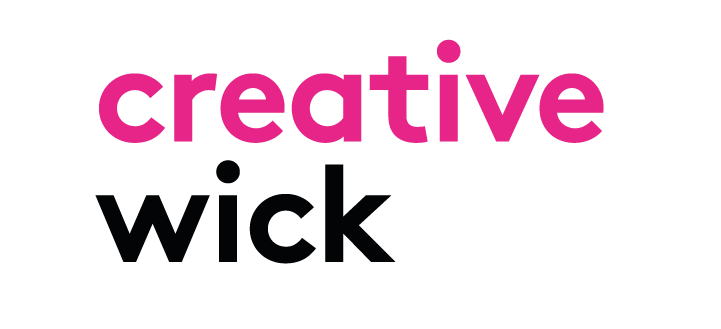
The Best Eating & Drinking on Fish Island
Your timely reminder to go visit these amazing restaurants, bars and cafes this summer while we wait for better bridge access…
Your work has a very distinct style, there’s movement and kinetic energy. How did this come about?
I used to do these very big, black and white paintings as I’m really not a colour person, I don’t know why. I don’t paint at all now, it’s really all about the drawing and being able to take things out and shift them around. The work gains that movement and kinetic energy because I want to say that I’m in the city city and that we’re all moving around.
It’s about journeys, where we meet each other, then pass, look at certain things and carry on going around. I originally come from a really small little remote town called Great Harwood, near Accrington, so when I went to college in Liverpool that was it for me, the city and the movement and the architecture, and all the people really busy…
I later came to London to do postgraduate in painting and drawing, then I went to the Royal College to do an MA in printmaking.

Why did you start using charcoal to draw the urban landscape?
Well, it’s easy to shift and move, you can put an idea down and then you can rub it out. Then, when you put something else on top, it gives you different layers and a sense of movement that things are happening underneath. All my pictures are not about one moment in time, they are about lots of different ideas, so I go out and do lots of pencil sketching on location. I might go to New York, I might go to China.
These drawings are generally in pencil, but it could be charcoal or pen. When I come back to my studio I have a really big roll of paper on my wall, and I start thinking how
I can put these different pieces of information together, as it might be that they’re from different weeks, or even months, and certainly from different times of day.
Then I might go back to the place, and I might see a different thing on that occasion, so it’s all layering and that is what gets you the movement.
It’s a really effective technique, but don’t you find it difficult to see what you’re doing because there is so much going on in the work?
Yeah, I’ve got too much information and sometimes the parts just live in this kinetic haze, I can see it but some people can’t. It’s really about not knowing where it’s going to finish, not knowing what kind of journey. What about if I do this? What if I rub that out? Ah ha! It’s the wrong thing. What if I put it back in? What if…

Do you think it’s a reflection of how you are, and therefore how you see the world?
Well, I am quite hyper as a person, I really like looking at things, and when I go abroad I only go for seven or eight days so I have to put everything down really quickly. Then, I get home and realise I simply can’t remember everything.
I have got this energy where I want to put down everything, but it’s actually about time and journeys and looking at things in slightly different ways.
My work reflects a kind of energy from myself combined with what I feel from the city. It’s all about change, especially in construction. I love doing it all.
Why do you particularly like drawing construction projects?
The idea is all around putting things up, taking things down, cities changing.
I found some drawings I did the second day of the Orbit being built in the Olympic Park and then some from the weeks after. It’s how everything comes together slightly differently and its changes. I love it.
Right here used to be home to the biggest fridge mountain in Europe and everyone came and threw all kinds of crap on it. There were some businesses and artist studios nearby and it was awful for those people. Then they said the Olympics were coming there to smarten it all up and we thought ‘yeah, right.’ It was like saying it was coming to Accrington; nobody believed it.
But everything went down and came up and I have got drawings from start to finish. I’ve seen 10 years and more of something changing through construction with cranes. I really love cranes, as their job is essentially to move, so you’ve got to anticipate them moving.


What other cities do you really like to visit and any particular place you enjoy to draw?
New York is my favourite city and Grand Central Station I absolutely adore. I enjoyed drawing in Dubai, which is such a strange place, with all the different changes there. I stayed in this hotel where I used to draw on top of the roof at five o’clock in the morning because it was too hot at any other time. I fancy going back to Hong Kong, but it’s not a good time there now.
Las Vegas was funny, as they have all these different kinds of buildings.
I stayed in this Bali-themed hotel, and next to me were the Pyramids, which were next to Camelot. They are all half size, which is funny.
Another inspiring place is Tokyo at the Shibuya Crossing. I stood in the middle and said this is it! Give it to me.
Do you have a process for drawing in public that you can share, as it must be quite a challenge?
In my book City Sketches Reimagined is a picture from my time at Shibuya Crossing. It doesn’t bother me drawing in public and when I teach people how to go out to draw there are some basics.
Essentially don’t make any eye contact, that’s the main thing, and just be really pleasant to people and keep on going. It’s a weird kind of experience working on art outside, but I just get on with it.
My husband has created a website called We Explore Drawing (weexploredrawing.co.uk) and now we do regular workshops in schools around the country. During the pandemic we started doing it online for adults as well.

Directly outside your studio in Fish Island the landscape changes constantly. Which parts do you really like to draw?
I’ve made monotypes during the time of the Olympics and I’ve been doing prints of what is happening now. I’m always taking photographs and have made a lot of prints of the Orbit, the Velodrome and the housing in the park.
What’s happening now with the V&A and the East Bank, I’m quite into it, so I’m always out taking photographs.
I’ve got a really big drawing up in Forman’s Smokehouse and I’d love to get these artworks displayed somewhere in the park. I’d like to be invited to do some drawing there, because it’s amazing what’s happening – for good or for bad. This area’s changed so much.
What do you want people to feel when they see your work?
I want people to go in really close to have a look, because you can’t see it all from standing back.
I create work that’s big, so you have the feeling of actually entering the drawing. You can almost walk into it, feel your way around, and elements you won’t see to start with will gradually come upon you.
I’m trying to make my work quite intriguing, encouraging the audience to actually participate.

Aside from the architecture, your work sometimes features people as part of the Aside from the architecture, your work sometimes features people as part of the urban landscapes, too.
I love drawing people! I’ve been a life drawing tutor for 30 years and I focus a lot on people moving. Sometimes they are really huge – the one I did in Shanghai is massive – and some are tiny.
One of my most recent works is of Canning Town station. I like that as a location to draw because it sees so many different types of people pass through. You get the ones who live in Canning Town, you obviously get all the big business types, and then you also get all the variety of characters coming to City Island.
People make buildings come alive. There’s no city without its population. Humans construct the buildings, and they make the cities come alive. As an artist, they are your key. You have to look after them. I love being in the city and drawing different bits of it precisely because I get to observe all these different kinds of people going about their daily lives.

Your timely reminder to go visit these amazing restaurants, bars and cafes this summer while we wait for better bridge access…

The twist and turns of post-Olympics decision-making that brought 250,000 objects to Here East

This thoroughly modern restaurant may be far from the taverna, but it’s filled with Mediterranean flavours, and much more
A joint venture in collaborative local media from:


In partnership with

Regulated by IMRESSS, the Independent Monitor for the Press CIC.
For more info on our complaints policy, or to make a complaint, visit FAQ.
